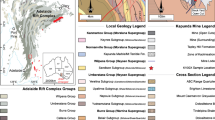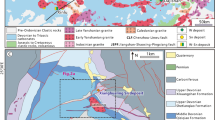Abstract
Pliny the Elder (first century A.D.) mentioned that the Thessalian magnetite from Magnesia in ancient Greece was second in quality after the Ethiopic. This magnetite should be related with the origin of the Homeric Magnetes of the eighth century B.C. who lived around Ossa mountain in central Greece. A new euhedral magnetite occurrence derived from the Kampitsios area at the north-western slopes of Mavrovouni mountain in “Amyrikon Pedion”, probably shows that this region should have been connected with the origin of the Homeric Magnetes. The magnetites under study are found as porphyroblasts in the talc schists. They are almost pure with rare inclusions, mainly ilmenite, rutile, pseudorutile and a PbO phase. The alteration of magnetite to hematite is restricted only along the fissures and cracks as well as along the rims, forming very thin films of a few micrometres in thickness. Microprobe analyses showed that the magnetites are almost pure and they contain only traces of Cr2O3 (1.01–3.41%). The high-quality magnetites of Kampitsios could be probably related with those mentioned by Pliny, and they should be related with the origin of the Homeric Magnetes of the eighth century B.C. who lived around Ossa mountain in Thessaly.



Similar content being viewed by others
Notes
Etymology: LSJ (Liddell-Scott, A Greek-English Lexikon)
Etymology: LSJ (Liddell-Scott, A Greek-English Lexikon)
Etymology: Fick, Bezz. Beitr. 24, 298
Pliny, Naturalis Historia, XXXVI, 127. Translated by D.E. Eichholz. Cambridge, MA, Harvard University Press, London, The Loeb Classical Library, 1962.
Plato, Ion, 533d.
Theophrastus, About Stones, 4
Plato, Ion, 533d. Translated by W.R.M. Lamb. Cambridge, MA, Harvard University Press, London, William Heinemann Ltd. 1925.
Aristotle, About Animals, I.2,405a
Theophrastus, About Stones, 29
Lucretius, De Rerum Natura, 6.906. Translated by William Ellery Leonard, New York, E.P. Dutton. 1916
Pliny, Naturalis Historia, XXXIV, 147. Translated by D.E. Eichholz. Cambridge, MA, Harvard University Press, London, The Loeb Classical Library, 1962
Pliny, Naturalis Historia, XXXVI, 126. Translated by D.E. Eichholz. Cambridge, MA, Harvard University Press, London, The Loeb Classical Library, 1962
Pliny, Naturalis Historia, XXXVI, 128
Dioscouridis, About Stones, 21
Orphic Lithica, 307. Translated by E. Abel, Berolini, Calvary, 1881
Pliny, Naturalis Historia, XXXVI, 192. Translated by D.E. Eichholz. Cambridge, MA, Harvard University Press, London, The Loeb Classical Library, 1962
Theophrastus, About Stones, 41
References
Bailey KC (1932) The elder Pliny’s chapters on chemical subjects, vol 2. Edward Arnold, London
Caputo R (1990) Geological and structural study of the recent and active brittle deformation of the Neogene-Quaternary basins of Thessaly (Central Greece). PhD thesis, University of Thessaloniki
Cornell RM, Schwertmann U (2003) The iron oxides: structure, properties, reactions, occurrences and uses. Wiley-VCH, Weinheim
Danelian T, Robertson AHF (2001) Neotethyan evolution of eastern Greece (Pagondas Mélange, Evia island) inferred from radiolarian biostratigraphy and the geochemistry of associated extrusive rocks. Geol Mag 138:345–363
Étienne R, Knoepfler D (1976) Hyettos de Béotie et la chronologie des archontes fédéraux entre 250 et 171 avant. J C BCH Suppl III:338–341
Helly B (1987) Le Dotion Pédion et les origines de Larisa. J Savants 1988:127–158
Helly B (2010) Géographie et histoire des Magnètes de Thessalie, I. De la plaine thessalienne aux cités de la côte égéenne, 750- c. 300 av. J.-C. (in press).
Katsikatsos G, Vidakis M, Migiros G (1981) Platycampos sheet, Geological map of Greece, scale 1:50,000. IGME, Athens
Kilias A, Mountrakis D (1989) The Pelagonian nappe. Tectonics, metamorphism and magmatism. Bull Geol Soc Greece XXIII 1:29–46
Kordatos J (1960) History of Volos and Aghia province. 20th Century Publications, Athens (in Greek)
Melfos V (2008) “Green Thessalian Stone”: The Byzantine quarries and the use of a unique architecture material from Larisa area, Greece. Petrographic and geochemical characterization. Oxf J Archaeol 27:387–405
Migiros G (1993) Stratiform siliceous iron and the metalliferous sulfide deposits of the Kalamaki—Elafos area in eastern Thessaly (Central Greece). Miner Wealth 82:33–42 (in greek)
Migiros G, Economou M (1988) Chromites in the ultrabasic rocks East Thessaly complex (Central Greece). Ofioliti 12:127–136
Mposkos E, Perraki M (2001) High pressure Alpine metamorphism of the Pelagonian allochthon in the Kastania area (Southern Vermion), Greece. Bull Geol Soc Greece XXXIV 3:939–947
Philpots AR (1989) Petrography of igneous and metamorphic rocks. Prentice Hall, Englewood Cliffs
Ramdohr P (1980) The ore minerals and their intergrowths. Pergammon Press, Oxford
Reischman T, Kostopoulos DK, Loos S et al (2001) Late Paleozoic magmatism in the basement rocks southwest of Mt. Olympos, Central Pelagonian zone, Greece. Bull Geol Soc Greece XXXIV 3:985–993
Robertson AHF, Clift PD, Degnan PJ, Jones G (1991) Palaeogeographic and palaeotectonic evolution of the Eastern Mediterranean Neotethys. Palaeogeogr Palaeoclimatol Palaeoecol 87:289–343
Stählin F (1924) Das Hellenische Thessalien. Verlag Von J. Engelhorns Nachf, Stuttgar (in greek Kyriakidis brothers, Thessaloniki, 2002)
Teller F (1880) Geologische Beschreibung des südöstlichen Thessalien. Denkschriften der Kaiserlichen Akad. der Wiss. Mathem Naturwiss Cl 14:183–208
Thonemann P (2007) Magnesia and the Greeks of Asia (I.Magnesia 16.16). Greek Roman Byzantine Stud 47:151–160
Wallace R (1996) “Amaze your friends!” Lucretius on magnets. Greece Rome XLIII 2:178–187
Acknowledgments
We express our special thanks to Mr. Elias G. Nasiaras, agriculturist, from Prinia village in Thessaly for his kind help in the field work and for the interesting information about the magnetite occurrences. We also thank the two anonymous reviewers who improved the initial manuscript with their comments.
Author information
Authors and Affiliations
Corresponding author
Rights and permissions
About this article
Cite this article
Melfos, V., Helly, B. & Voudouris, P. The ancient Greek names “Magnesia” and “Magnetes” and their origin from the magnetite occurrences at the Mavrovouni mountain of Thessaly, central Greece. A mineralogical–geochemical approach. Archaeol Anthropol Sci 3, 165–172 (2011). https://doi.org/10.1007/s12520-010-0048-6
Received:
Accepted:
Published:
Issue Date:
DOI: https://doi.org/10.1007/s12520-010-0048-6




